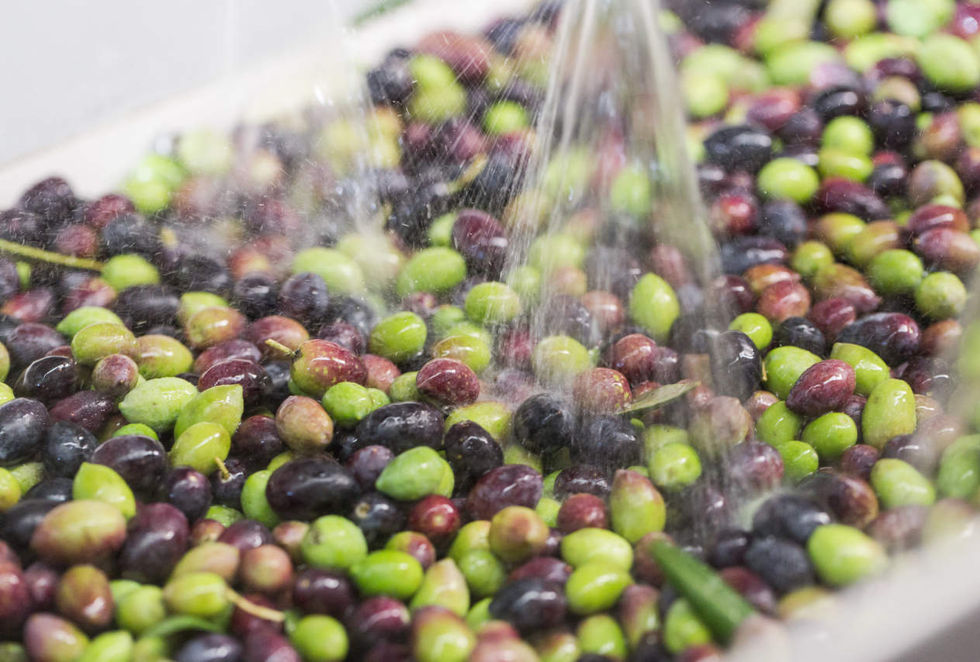
Productive process
The phases of the creations of our oil
CHARACTERISTICS OF THE OLIVE TREE
WHAT HAPPENS ON THE FIELD
THE COLLECTION PHASE
THE DERAMIFOGLIAZIONE
THE WASHING PHASE
CRUSHING AND MIXING
EXTRACTION OF OIL
The olive tree is an evergreen tree with continuous vegetative activity, with attenuation during the winter period. It has a slow growth and is very long-lived, in fact, if placed in its favorable climatic conditions, it can even become millennial. In general, the olive tree prefers a temperate climate, a typical climate that we find in the Mediterranean basin.
During the first months of spring and the end of summer, the flowers of the olive tree, the little fingers, are transformed into fruit, the drupe. The ripening process is very slow, in fact it is completed in the months of November and December. During these months, the shape and color of the olive change: initially we have a green olive and then move on to a red color, up to the purple color, which represents the highest degree of ripeness. perfect harvesting period is when the color of the drupe is halfway between green and purple .
We thus move on to the harvesting phase. The Azienda Agricola La Valle uses harvesting techniques, which do not cause damage to the olive tree and the drupe, in order to keep the characteristics and integrity of the fruit perfect and unaltered. The harvesting techniques we use are modern but respect the tradition, mechanically replicating the beating, shaking and combing. These techniques allow to harvest the olives at the right degree of ripeness, intact, healthy and ready to be taken to the Frantoio. A method NOT used by our company is the expectation of the spontaneous fall of ripe olives , as this method of harvesting produces an oil with serious organoleptic defects and a high degree of acidity.
The de-leafing of the olives consists in freeing the mass of the olives to be processed from twigs and leaves. This activity is carried out with special rotary machines, the same machine is equipped with a suction stage to remove the leaves and keep only the olives. During this whole phase, it is necessary that the olives do not suffer excessive impacts, such as to break or crush the drupe.
The mass of the olives, in a continuous and constant way by means of belt conveyors, reaches a washing station in water with a special washing machine with a constant flow of water that invests the path of the olives. At the exit of the olives from the machine, there is a spray of clean water, which is used to rinse the olives from the washing water, for optimal cleaning of the olive ready to be crushed
The pressing consists in the crushing of the olive together with the stone. The pressing technique used by our company is that of the Knife pressing. Let's now pass to the most important phase regarding the transformation of olive into oil and that is the Gramolation. This phase allows the olive paste to reach a maximum temperature of 27 ° C (cold extraction), at this point the small droplets of oil join together forming ever larger drops that are much easier to extract. The times of kneading vary according to the type of cultivar being worked and also from its degree of ripeness usually the time is around 35 minutes. This allows the optimal extraction of our Organic Extra Virgin Olive Oil
The olive paste, immediately after kneading, is constantly pumped towards a centrifugal separator with a horizontal axis called the Decanter. This machine allows to separate the three components present in the pasta, namely, oil, vegetable water and pomace, by exploiting the different specific weight of all these substances. After the Decanter, a further separation is carried out in order to completely eliminate the water from the final product. In this last machine the oil is purified of water and small solid impurities and is channeled in a specific path to then be collected and carefully stored in stainless steel tanks








